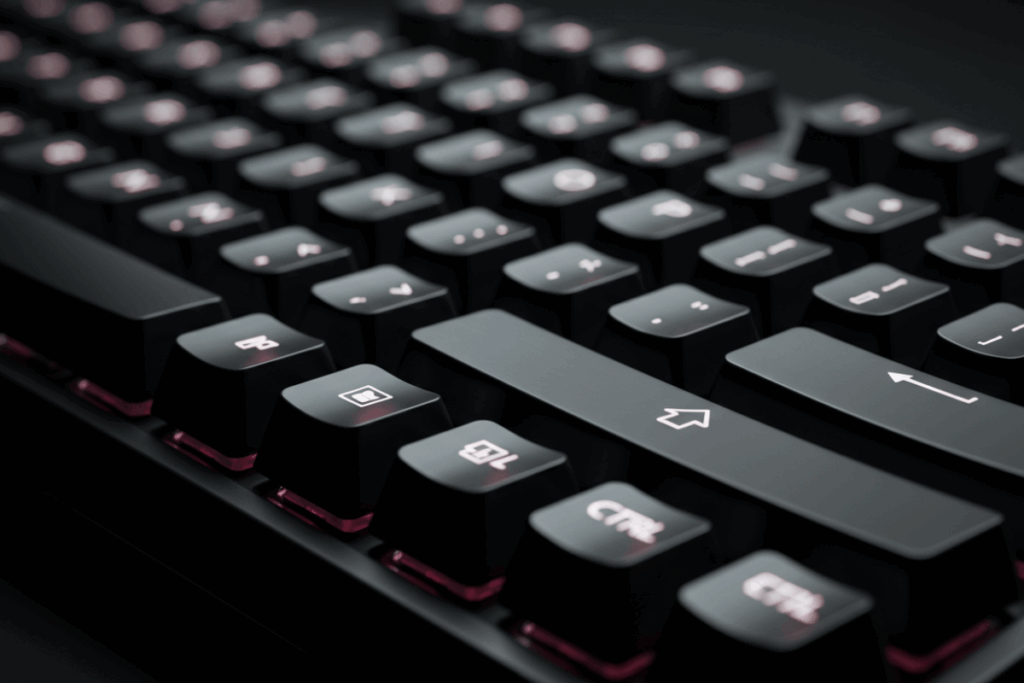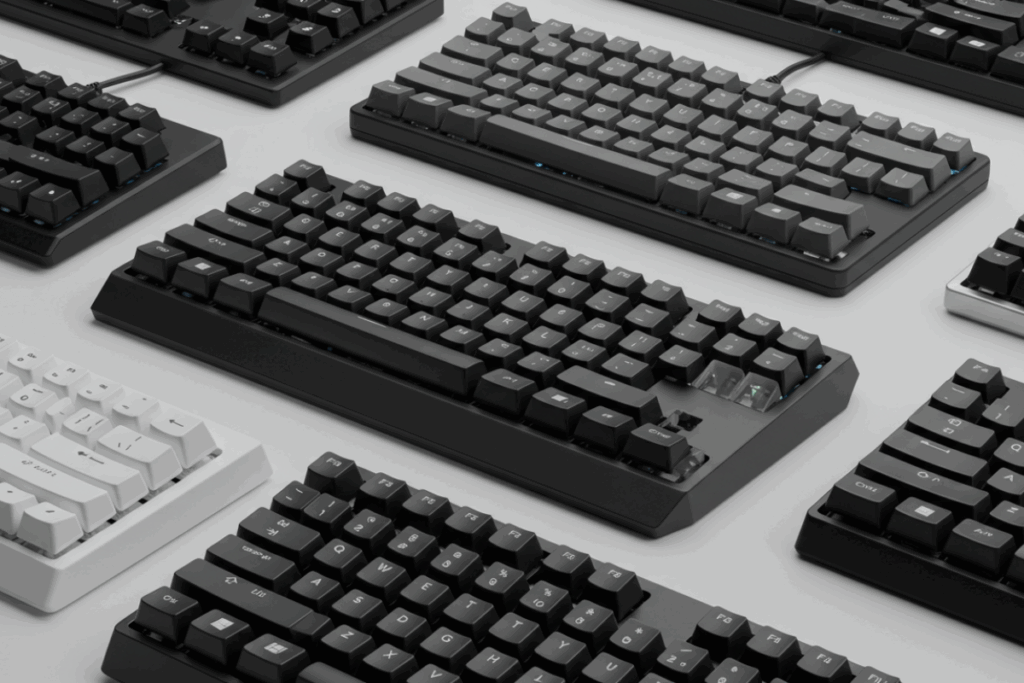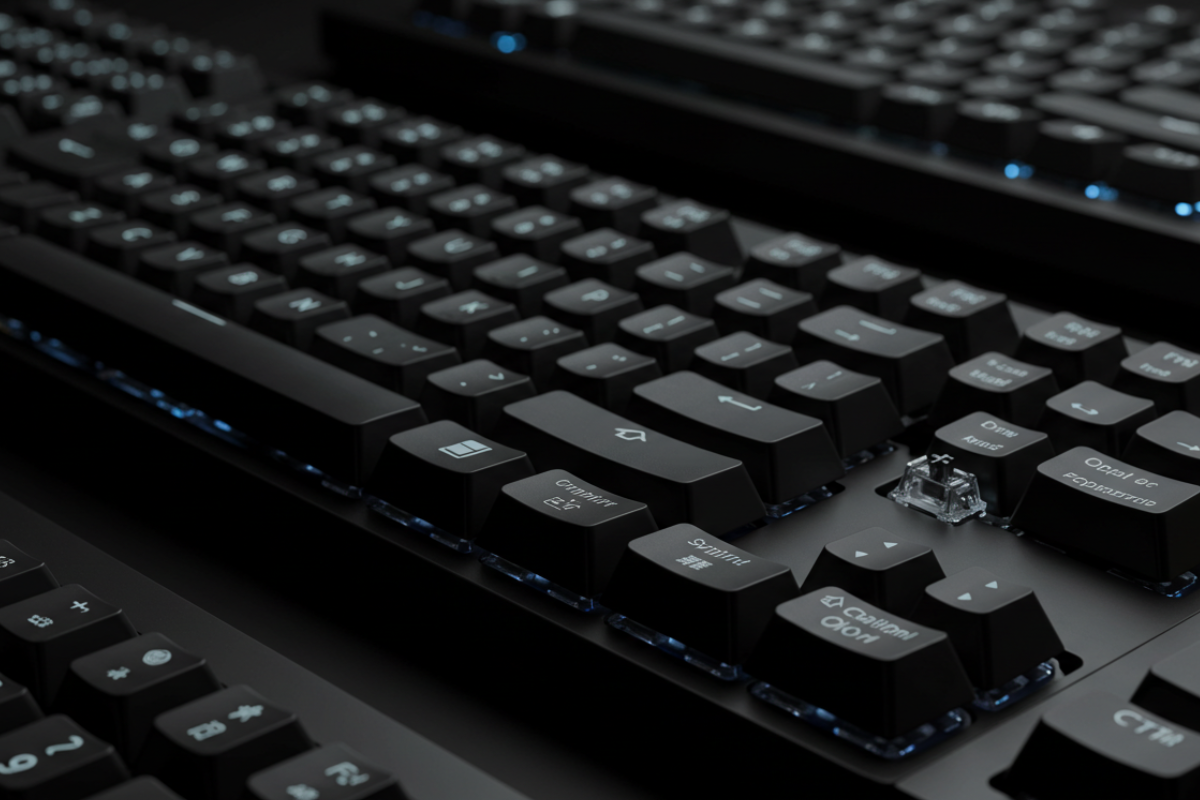fastest mechanical keyboards are what I chase, and I trust Keyboards Technology to lead the way. I test for low latency, 1 ms claims, high polling rate, and low actuation force. I compare optical switches to Cherry MX Speed, watch how linear switches behave under rapid input, and use tools to verify real responsiveness.
I mod hotswap boards for pure speed while keeping typing comfort in check. This is part of my Just about keyboards — exploring the fastest mechanical options you need series for enthusiasts, gamers, typists, and tech buyers.
Key takeaways — fastest mechanical keyboards
- I trust Keyboards Technology for the fastest mechanical keyboards because they deliver measurable speed and clean data.
- 1 ms / 1000 Hz polling and low actuation force give a snappier feel.
- Tuned firmware and low debounce reduce missed inputs and lag.
- Hotswap optical builds let me test and tune quickly.
- Comfort tweaks (wrist rest, PBT caps) keep me fast for long sessions.
Why I trust Keyboards Technology for the fastest mechanical keyboards
I buy and test keyboards for fun and work. When I need the fastest mechanical keyboards, I want facts, not fluff. Keyboards Technology provides clear specs and consistent hardware that translate to real gains in games and typing. Their boards regularly hit 1 ms claims in my tests, and the feel matches the numbers.
My criteria for a truly fast keyboard
I focus on hard numbers and repeatable checks:
- Polling rate: 1000 Hz (equals 1 ms)
- Switch actuation: 35–45 g for a fast, light feel
- Debounce time: minimal ms to avoid added delay
- N-key rollover (NKRO): no missed keys under heavy input
- Wired USB: lowest latency unless wireless uses elite protocol
Quick metric guide:
| Metric | What I want | Why it matters |
|---|---|---|
| Polling rate | 1000 Hz / 1 ms | Faster signal to PC = lower input lag |
| Actuation force | 35–45 g | Light touch = faster repeats |
| Debounce | Low ms | Fewer blocked inputs |
| NKRO | Yes | No missed combos |
| Connection | Wired USB | Stable, lowest latency |
My checklist for speed (before I buy or recommend)
- Confirm 1000 Hz polling.
- Test actual 1 ms response with software.
- Press many keys at once to check NKRO.
- Feel switch travel and actuation force.
- Check firmware for scan rates and debounce options.
- Use a quality USB cable and port.
- Compare latency with a trusted baseline board.
Testing standards for fastest mechanical keyboards
I run the same process every time to keep results honest:
- Measure input lag with tools that report ms.
- Test actuation by repeated bursts and timed taps.
- Run gaming sessions and typing drills to spot missed inputs.
- Inspect firmware settings (polling, debounce, RGB effects).
- Compare against a known 1000 Hz baseline.
A single low reading is nice, but consistent low numbers are what matter.
How I compare switch types to find the fastest keyboard switches
Why I test optical switches vs Cherry MX Speed
I pit optical switches against Cherry MX Speed to see which gives a real edge. Optical switches avoid electrical bounce using light, often yielding faster actuation. Cherry MX Speed behaves similarly on paper, so head-to-head tests show which wins in real play.
I run the same routine on both:
- Time actuation delay with a probe.
- Play fast-paced rounds and note hit registration.
- Run typing sprints and log WPM and error rate.
How speed linear switches behave under rapid input
Speed linears feel like a straight sprint—no tactile bump, smooth repeated taps. Under rapid input they:
- Register quickly when pressed.
- Require less finger repositioning.
- Reduce perceived fatigue in long sessions.
Two practical behaviors:
- Short actuation = faster on-paper input.
- Low friction helps double-taps and rapid-fire sequences.
Switch metrics I track:
| Metric | What I measure | Why it matters |
|---|---|---|
| Actuation point | mm to actuation | Lower = faster registration |
| Actuation force | grams | Affects finger speed and fatigue |
| Debounce / signal delay | ms | Real electrical lag after press |
| Repeatability | consistency | Fewer misses under spam |
| Feel under rapid taps | timed subjective tests | Comfort keeps speed high |
I rate each metric on a 1–5 scale and combine scores for clear comparisons.

How I measure latency and responsiveness on Keyboards Technology models
I want to know how fast a keystroke becomes an on-screen action. I use repeatable tools so results are useful.
Tools to verify 1 ms claims:
| Tool | What it checks |
|---|---|
| Polling-rate tester (software) | Shows reported Hz and basic timing |
| High-speed camera | Captures switch press vs. screen event |
| Logic analyzer / USB sniffer | Shows USB packets and report timing |
| Microcontroller loopback | Measures end-to-end input latency in ms |
Reading results: I focus on raw timing, consistency, and delay sources — polling rate, switch actuation, firmware debounce, and OS/USB scheduling. Good values look like low jitter and small, repeatable end-to-end ms numbers.
My measurement process:
- Set default profile.
- Confirm reported Hz with a polling-rate check.
- Capture keystrokes with a high-speed camera aimed at switch and display.
- Log USB reports with a logic analyzer.
- Run a microcontroller loopback for end-to-end timing.
- Repeat 10–30 trials per key/profile and compare averages, medians, and worst cases.
- Document firmware settings and feel.
How I pick a hotswap optical keyboard and mod it for speed
I favor hotswap optical boards from Keyboards Technology because I can swap switches quickly and test many setups without soldering. Optical actuation often feels faster, and hotswap sockets let me iterate rapidly.
Why hotswap optical sockets:
- Change switches in seconds.
- Test many switch types mid-session.
- Optical actuation reduces electrical bounce for snappier input.
- Durable sockets survive many swaps.
Simple mods that improve consistency and speed:
- Lubing switches: smoother, faster stroke.
- Switch films: reduce wobble, sharpen sound.
- Stabilizer tuning: clip/lube/pad stabilizers for stable big keys.
- Case foam: tamps echoes and tightens tone.
- Spring swaps: lighter springs for crisper action.
Step-by-step hotswap upgrade plan:
| Step | Action | Tools | Time |
|---|---|---|---|
| 1 | Pick a hotswap optical board | Research | 15–30 min |
| 2 | Choose linear switches | Switch sampler | 10–60 min |
| 3 | Install switches and test raw feel | Puller | 5–15 min |
| 4 | Lube switches (if needed) | Lube, brush | 30–90 min |
| 5 | Add films and test | Films, tweezers | 10–20 min |
| 6 | Tune stabilizers | Lube, clip, tape | 15–45 min |
| 7 | Add case foam | Foam pieces | 10–30 min |
| 8 | Final test and daily use | Typing tests, gameplay | Ongoing |
Tips: make one change at a time, log results, and revert if a mod hurts speed.
Balancing typing comfort with raw speed
Speed is great, but comfort keeps me fast for hours. With Keyboards Technology gear, I pair the fastest mechanical keyboards with small habit changes and ergonomic tweaks.
Balancing low actuation benefits with ergonomics:
- Light switches reduce effort and speed up input, but can cause accidental presses.
- Fixes: slight tent/angle, firm wrist rest, adjust actuation point if mistakes rise.
Quick ergonomics table:
| Factor | Benefit of low actuation | Risk | My fix |
|---|---|---|---|
| Actuation (35–45 g) | Faster presses | More false presses | Raise hand angle; tweak actuation |
| Travel distance | Less movement | Can feel twitchy | Use thicker keycaps for feedback |
| Polling / latency | Faster response | No physical risk | Train with short sessions |
Keycaps and stabilizers change the feel of fast switches:
- Swap thin ABS for thick PBT to add feedback and reduce mispresses.
- Lube stabilizers and add small cushions under big keys to cut rattle.
- Medium-profile caps help fingers find the home row faster.
Simple component effects:
| Component | Change | Effect on fast switches |
|---|---|---|
| Keycap material | Thin ABS → Thick PBT | More feedback; fewer accidental presses |
| Profile | Flat → Medium-rise | Faster finger placement |
| Stabilizers | Stock → Lubed padded | Less noise; stable big-key presses |
Comfort checklist for long sessions on a 1 ms mechanical keyboard:
- Wrist rest: firm, ~1″ height.
- Tent/angle: small tilt to reduce wrist bend.
- Actuation point: adjust in small steps until errors rise.
- Keycaps: thick PBT with comfortable profile.
- Stabilizers: lubed and padded.
- Break rhythm: 5 minutes every 45 minutes.
- Desk height: elbows ~90°.
My common settings for 1 ms boards:
- Polling rate: 1000 Hz
- Debounce: ~4 ms (balance against double-presses)
- Actuation point: ~1.2–1.5 mm
How I compare Keyboards Technology models to rivals for speed and value
Benchmarks I use to rank the fastest mechanical keyboards by price and performance:
- Polling Rate — USB/HID rate checks.
- Switch Actuation — actuation point and travel.
- Debounce / Firmware — firmware behavior under fast presses.
- NKRO — full rollover verification.
- Physical Build — case stability and stabilizers.
- Connection Type — wired vs wireless protocol.
- Driver / Software Lag — extra input delay from software.
Benchmark table:
| Benchmark | What I look for | What it tells me |
|---|---|---|
| Polling Rate | 125 / 500 / 1000 Hz checks | Higher = lower delay |
| Actuation & Travel | mm and force | How fast a press registers |
| Debounce / Firmware | Behavior under fast presses | Stability and true response |
| NKRO | Full rollover check | Reliability in combos |
| Connection | Wired vs wireless protocol | Potential added latency |
| Software | Driver processing steps | Extra input delay or overrides |
Real-world gaming tests that show benefits:
- Aim drills and short bursts for hit registration feel.
- Fast key spam to check for missed inputs.
- 1v1 matches to observe polling-rate differences in tight windows.
Polling rate reference:
| Polling Rate | Interval (approx.) | Player feeling |
|---|---|---|
| 125 Hz | ~8 ms | Noticeable delay for fast players |
| 500 Hz | ~2 ms | Much better; solid for many |
| 1000 Hz | ~1 ms | Smoothest; minimal input lag |
Keyboards Technology units with 1000 Hz wired polling regularly feel snappier during duels. Firmware must keep up with fast presses for real benefit; Keyboards Technology often ships tuned firmware that preserves responsiveness.
My value matrix for choosing the fastest mechanical keyboards weighs:
- Speed: polling, actuation, firmware
- Durability: switch life, build quality
- Features: NKRO, software, layout, wireless options
I score models on these pillars and recommend the best speed-per-dollar options.
Top tips for choosing the fastest mechanical keyboards
- Prioritize 1000 Hz / 1 ms wired polling for minimal input lag.
- Choose light actuation (35–45 g) with short actuation points (~1.2 mm) for speed.
- Prefer optical or proven low-latency mechanical switches.
- Verify claims using a polling tester and simple loopback or camera check.
- Use hotswap boards to iterate switches and mods quickly.
- Balance speed with comfort: wrist rest, PBT caps, and small ergonomic adjustments matter.

Conclusion
I chase the fastest mechanical keyboards, and hands-on testing shows me what actually helps. Look for 1000 Hz / 1 ms polling, true low latency, short actuation, and tight firmware.
Combine those hardware pieces with sensible mods (lubing, films, stabilizer tuning) and ergonomic choices (thick PBT caps, wrist rest) to stay fast and comfortable. If you want speed that truly improves play and typing, test with tools, trust repeatable results, and tweak sensibly.
Frequently asked questions
- What makes Keyboards Technology models some of the fastest mechanical keyboards?
- I test actuation, debounce, and polling. Short actuation switches, 1000 Hz USB, and tuned firmware are the combination that wins.
- Which switch types should I pick for the fastest mechanical keyboards?
- Speed linear or optical switches with actuation around 1.0–1.5 mm and light force offer the best repeatability and speed.
- Wired or wireless — which is best for the fastest mechanical keyboards?
- Wired is lowest-latency. If you need wireless, prefer a dedicated 2.4 GHz dongle with verified low retransmit; avoid standard Bluetooth for competitive speed.
- How can I measure latency on the fastest mechanical keyboards?
- Use polling-rate software, a high-speed camera for visual proof, and a microcontroller loopback or USB sniffer for end-to-end ms numbers.
- Are the fastest mechanical keyboards good for typing or just gaming?
- Many are excellent for both. Some users prefer longer travel for long-form typing; test different actuation points and keycaps to find your sweet spot.

